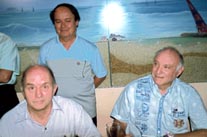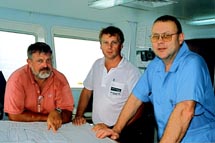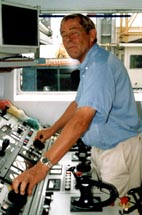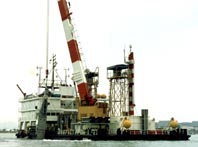|
Journalism students visit Pattaya Mail
Celebrating the 52nd Anniversary of Sri Lankan Independence, 4 February 2000 An insight into exotic Sri Lankan cuisine When taste buds are truly tantalized, the food is indeed something to write home about. And Sri Lankan food is a symbol of serendipity in that you come across something wonderful unexpectedly, just as Sri Lanka has long been known as the Isle of Serendipity, complete with magical discoveries. The culinary discoveries in particular, are as subtle as they come, blended with and enriched by a diversity of cultures and ways of living, in a form of cooking that combines the art and science of food that has survived the test of time. Since ancient times Sri Lanka, with its strategic geographic location, has had contact with different cultures and races, including Indians, Arabs, Moors, Malays, later on, the Portuguese, the Dutch and the British. Each of these cultures has left their imprint upon Sri Lankan life including its cuisine, so much so it is hard to identify dishes which are authentically Sri Lankan. Tales of historical interest say that during the times of the Singhalese kings, royalty and commoners alike used black peppercorns to prepare game, fish and vegetables. After 1505 with the arrival of the Portuguese, Sri Lankan cooking acquired the custom of using red chili in the curries. Sri Lanka being an agricultural country once glowingly termed “ the Granary of the East”, has as its staple food, rice eaten with curry. The word “curry” covers a multitude of mouthwatering dishes, not just a bowl of curried meat or vegetables. Sri Lankan curries are known for their fiery hot, spicy flavors, with coconut a distinctive addition, usually in the form of milk for gravy. The curies that Sri Lankans eat with their rice focus on a balanced diet comprising a variety of vegetables with fish or meat and greens. Sri Lankan cooks are very particular to have curries which blend well together to heighten the pleasing effects on the palate. There is specially the homely “pol sambol” - grated fresh coconut mixed well with red chili powder/pieces, salt, maldive fish and lime juice, which rises magnificently to any occasion to add a dimension of thrill to any meal. It deserves the general commendation of being “a rice-puller”. Curries are usually of three kinds - white, red and black, and have as their base coconut milk. White curries obtain their milky yellow color from turmeric powder and are mild and lightly spiced. Red curries contain large quantities of chili powder and spice. Black curries are made with a paste of coriander, cumin and sweet cumin roasted to a dark brown. Chili powder is also roasted to further darken the color. A typical Sri Lankan lunch or dinner table has a steaming hot dish of boiled rice surrounded by aromatic and richly spiced curries usually swimming in thick coconut milk gravy. Though rice and curry is essentially Sri Lankan, this is qualified in instances of variations of rice, tempered (in itself a Portuguese word) with ghee, spiced, fried or boiled in various kinds of stock or coconut milk, showing a non-indigenous strand adapted to suit the Sri Lankan palate. Rice takes on auspicious tones in “kiribath” literally “Milk-rice” cooked in coconut milk and salt, eaten generally with jaggery made of the kitul palm, bananas and “lunu miris” - a potent preparation of onion, chili, maldive fish, salt and lime juice. Traditionally kiribath is served on auspicious occasions like the dawn of a New Year, weddings, births and other milestones in life. The range of Sri Lankan food extends beyond rice and curry into the crispy “hoppers” (something akin to pancakes with a crispier edge made from a rice-flour and coconut milk batter), to stringhoppers (a batter of water mixed with rice four) and pittu (steamed rice flour with scraped coconut and coconut milk). These preparations were introduced by neighboring Asian countries which have now become a part of authentic Sri Lankan cuisine through the use of such essentially local ingredients as coconut toddy, coconut milk, coconut treacle, and brown kurakkan flour.
Of course, an array of Sri Lankan food cannot miss out on Sri Lanka’s favorite dessert - curd and treacle. Curd is boiled, cooled and whisked buffalo milk poured into earthenware pots and left to set. Poetic descriptions wax eloquent on “the delicious, cooling, soothing effects and the slightly sour taste, creamy with a faint and tantalizing odor of god milk and fragrant wood smoke.” The curd is perfectly complemented by the thick warm brown treacle topping that titillates the palate of dessert lovers anywhere. Talk about Sri Lankan food and drink and one cannot forget Ceylon tea - known as the world’s finest, from the luscious tea gardens of Sri Lanka. Ceylon tea is very much available wherever Sri Lanka food abounds and appreciated as a health drink the world over. Thus, Sri Lanka, the exotic island of magical discoveries lives up to expectations all the way, captivating the imagination of food lovers on a voyage of culinary discovery. A Sri Lankan Food, Tea and Cultural festival will be held at the Landmark Hotel in Bangkok from 2nd-13th February. This a collaborative effort of the Embassy of Sri Lanka, Sri Lankan Airlines, Jetwing Group of Hotels in Colombo, the Landmark Hotel in Bangkok, the Ceylon Tourist Board and Dilmah Tea. Apart from the array of food prepared by expert Sri Lankan chefs of Jetwing Hotels Group, specially flown in by Sri Lankan Airlines, there will also be a tea promotion throughout the Festival where Dilmah tea will be served free. There will also be a display of Sri Lankan culture, handicrafts and the photographs of renowned Sri Lankan photographer Dominic Sansoni. As food and drink flow in abundance, guests will be serenaded by a group of Sri Lankan musicians playing Sri Lankan style calypso music - a legacy left by the Portuguese. So, if music is the food of love play on, and serenade also, the love of food.
A day in the life of a barge dweller The Pattaya Mail yachting scribe spent some time on the water, as usual, last week, diligently reporting what transpired. However, it was a rather different type of ‘craft’ to the usual sleek racing yachts of his reports, though it was markedly “hi-tech” - in fact, a leader in its genre. Peter Cummins reports Ever have a problem trying to telephone to Bangkok, from Pattaya? “I do, many times,” said Pattaya-based Dave Doll. But that will soon be a ghost from the past. Dave Doll, of the Sea and Oil Field Services Company, is the shore-end contractor for a huge fibre-optic submarine cable project, now under way at Laem Chabang, from the cable-laying barge, the Networker.
“What we are doing here,” Dave continued, “will bring Thailand in line with the most sophisticated communication systems now operating world-wide. “In the very near future, Thailand will enter the fast lane of the communications highway, with Internet, telephone and telecommunications connections equal to anywhere in the world,” Dave emphasized. Funded and commissioned by the Communications Authority of Thailand (CAT) and being implemented by Ericsson and Global Submarine Cable Systems, the project has started operations to lay some 850 km of fibre-optic cable in four sections: Laem Chabang to Petchburi; Petchburi to Chumpon; Chumpon to Koh Samui; and finally, Samui to Songkhla. It was most appropriate that I was commissioned to photograph the operations and to write a story for the Pattaya Mail, for the Networker was moored at Banglamung, just some 300 metres off the Banglamung Home for the Aged - a place which, in my dotage, appeals to me more each time I drive past it on the way to Bangkok.
To say that the massive, highly-technical operation was somewhat over my head would be the understatement of the New Millennium - or the old one, for that matter! Actually, the operation was ‘under my feet’ rather than ‘over my head’! Nevertheless, after coaxing my unwilling bones and muscles, atrophied after years of retirement inactivity, I managed to board the huge barge, climbing up from the rubber dinghy, bouncing in the turbulence created by 1,000 hp Rocksaw grinding away on the sea bed. It was just an ordinary day for the team aboard the Networker, the purpose-built cable working barge, the first of its kind designed for operating in South East Asian waters.
All of the personnel aboard were busily engaged in the myriad supporting activities that such a mammoth undertaking requires. Under the surveillance of a diver beneath the sea and the technical staff located at various monitoring stations around the barge, an operation to drill through a rock outcrop, with the Rocksaw, prior to laying fibre-optic cables on the sea floor, was then in progress. The only evidence to the untrained eye of what was happening beneath the water was the agitated surface and the colour of the surrounding water, reflecting the rock below. After the completion of this, the Injector Elbe, a massive mechanism shaped somewhat like a huge steel boot, was lowered by crane and activated. It was the conduit for feeding the cable to the sea-bed. According to Networker captain Abdul Lattif, depending upon the condition of the sea-floor and taking other variables into account, the barge can lay up to 20 km of cable in one working day of sixteen hours. “But that,” he pointed out, “is a good average. We go, as we are right now, from zero per hour to three km per hour.”
Nilserik Grip, the Senior Supervisor of Ericsson’s Submarine Cable System, and Frederic Harmstorf, a leading expert in submarine systems operating his own equipment, are both veterans of such operations and find nothing particularly daunting about their project. “All in a day’s work,” said Nilserik. New Zealander Peter Parkinson, Project/Site Manager and Beach Master, and Marten P. Webb, the Project Manager for Global Submarine Cables are confident that the work will be finished on schedule, “although,” Peter cautioned, “we are always at the mercy of the vagaries of the elements.” Some 12 nationalities comprise the personnel aboard the Networker which, for the statistically-minded, is 60m X 20.5m X 4m, draws up to 3m fully loaded and can carry up to 750 tonnes of cable. The barge can accommodate 46 personnel in 23 cabins and can remain for 45 days at a site.
Up until that fateful day when I was pushed, pulled and otherwise cajoled onto the gigantic deck of the barge, I never gave much thought to a topic called burial tools. They were just something to do with necrophilia, I thought: the shovels, coffins and ropes used to lower us down. Ah no! on the good barge Networker, there is a long list of burial tools at the disposal of the engineers: cable towers and trolley system, two one-tonne cable engines, the aforementioned Elbe injector for 10m burial in up to 60m of water depth, the Bantam and Panzer jetting plows for different operations and, of course, the Rocksaw, now lying quietly in its cradle, after hacking away at the sea floor for many hours. So, I left the barge and its denizens, somewhat wiser after my own day in the life of a barge dweller.
With all the excitement of finding your choice of the Pattaya Person of the Millennium, it was important not to forget some other very important people. Those were the people who took the time to consider their choice, the reasons and then actually send in their nominations. We at the Pattaya Mail thank all of you, and to show we really meant it, we had a prize draw (which was screened on the Pattaya Mail Channel) and drew out nine lucky prize winners. Five prizes of a year’s subscription to the Pattaya Mail, three prizes of clothing from Classic Tailor and the major prize, a return air ticket to Chiang Mai! The winners of the draw were: Air ticket - Dollawat Pukchoho (nominated Alois Fassbind) Classic Tailor - Nakorn Boriboon (nom. Fr. Brennan), Aumnuay Srinangnern (nom. Fr. Brennan), Phisamai (email entry) (nom. Fr. Brennan). Pattaya Mail - Suphaporn Namdaeng (nom. Fr. Brennan), Juniang Jangprai (nom. Alois Fassbind), Somwong Thasree (nom. Alois Fassbind), “Mick” (email entry) (nom. Fr. Brennan), Wollawoot Saewapun (nom. Alois Fassbind). All prize winners will be notified by mail or email and informed as to how to pick up their prizes. Congratulations all of you!
Sophin Tappajug - “First Lady” of Pattaya
Next week we will highlight the second most popular nomination, Louis Fassbind and the week after, the most popular vote, Father Raymond Brennan CSSR.
Diana Group greets the new millennium
Designed to cater for the “budget” end of the market, General Manager Khun Vinai said, “In our restaurant, we have the cheapest European food of this standard in Pattaya, and we are very proud of this.” Judging by the crowd who stayed on after the official opening, performed by Managing Director Sophin Thappajug and Pattaya Mail Publisher Peter Malhotra, the Diana Millennium House will very soon be a popular place for the golfing fraternity to drop in for a quick bite!
Copyright 1999 Pattaya Mail Publishing Co.Ltd. |
|
 This
is the Year of the Dragon
This
is the Year of the Dragon 40
journalism students from Chulalongkorn and Burapha Universities visited
the Pattaya Mail Publishing Company on an educational field trip.
40
journalism students from Chulalongkorn and Burapha Universities visited
the Pattaya Mail Publishing Company on an educational field trip. President
Bancha Mungchana presents the Rotary pin to Henny Vermey as Past President
Peter Malhotra carries out the induction formalities.
President
Bancha Mungchana presents the Rotary pin to Henny Vermey as Past President
Peter Malhotra carries out the induction formalities. District
Governor Premprecha Dibbhayawan keeps a watchful eye over Secretary George
Tomlinson and Treasurer Jon Tellefson.
District
Governor Premprecha Dibbhayawan keeps a watchful eye over Secretary George
Tomlinson and Treasurer Jon Tellefson. Sri
Lankans through the ages were mindful of the effects of their diet on their
health and in the days of old, the kitchen was a veritable workshop of
culinary skill where ingredients used in cooking were blended for medicinal
values and their pleasant aroma.
Sri
Lankans through the ages were mindful of the effects of their diet on their
health and in the days of old, the kitchen was a veritable workshop of
culinary skill where ingredients used in cooking were blended for medicinal
values and their pleasant aroma. (L
to R) David Doll, Peter Parkinson and Marten R, Webb: A management
perspective.
(L
to R) David Doll, Peter Parkinson and Marten R, Webb: A management
perspective. Nilserik
Grip: Ericsson’s leader.
Nilserik
Grip: Ericsson’s leader. Frederic
Harmstorf - a firm hand on the controls
Frederic
Harmstorf - a firm hand on the controls Inspecting
the operations
Inspecting
the operations The
“Networker” in action at Laem Chabang
The
“Networker” in action at Laem Chabang Pattaya
Mail Managing Director Peter Malhotra draws the winners under the watchful
eye of PM Channel’s Dr. Iain Corness.
Pattaya
Mail Managing Director Peter Malhotra draws the winners under the watchful
eye of PM Channel’s Dr. Iain Corness. Sophin
Thappajug
Sophin
Thappajug (L
to R) PSC Golf Chairman Mike Franklin, Sopin Thappajug and Managing Director
of Pattaya Mail Peter Malhotra cut the ribbon to officially open the new
Diana Millennium House.
(L
to R) PSC Golf Chairman Mike Franklin, Sopin Thappajug and Managing Director
of Pattaya Mail Peter Malhotra cut the ribbon to officially open the new
Diana Millennium House.